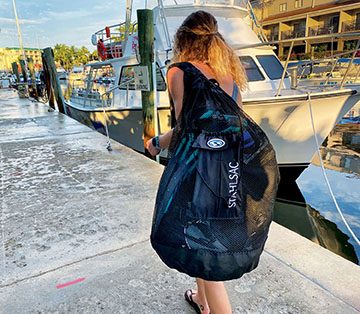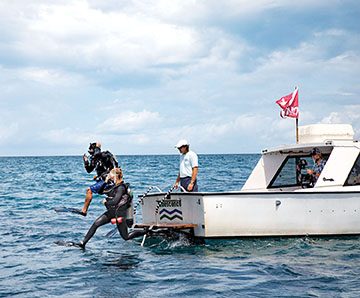“Everything you see is telling you a story. Are you listening?” — Butch Hendrick, Lifeguard Systems
DIVING INHERENTLY CARRIES AN ELEVATED LEVEL OF RISK because humans cannot survive underwater without specialized equipment. When things go wrong, an effective rescue is vital for a favorable outcome. Most rescue diver courses teach students basic techniques to apply after something goes wrong, but better courses also provide techniques to prevent incidents from occurring in the first place.
Divers who practice situational awareness are more likely to prevent a potential accident. It could be as simple as noticing a broken mouthpiece zip tie while gearing up or as complex as a panicking diver who is out of breathing gas. Mastering the art of awareness is not a simple task, and it can take divers years to become proficient at spotting potential problems.
Being an aware diver is often about identifying and solving problems before they become emergencies. Every diver should regularly practice rescue skills, but their goal should be to prevent incidents so they never have to use those skills. Deliberate observation can help make a dive incident- and accident-free by recognizing potential problems at each phase of a dive.
So when should the rescue begin?

In the Parking Lot
When planning a dive, divers should seek to correct any issues that could cause problems later. From the moment divers arrive in the parking lot, they should pay attention to everything around them to identify potential issues. How are the other divers acting? If those individuals are friends or acquaintances, pay attention to any abnormal behavior. Is the ordinarily talkative person suddenly quiet? Does the typically confident diver appear anxious? Talking to the nervous diver may reveal their own difficulties or safety concerns.
It is also important to listen to other conversations. Questions and comments from divers can give insight into their experience and training. Listening can help you learn important information and prevent egos from interfering with safety.
Pay attention to the condition of gear that divers remove from their vehicle. Appearance isn’t everything, but it can indicate how often a diver is in the water or how well they maintain their equipment. Well-used gear could suggest an individual who either dives frequently or one who neglects their equipment. Likewise, don’t assume that someone in well-used gear or a technical configuration is a well-qualified and competent diver. Conversely, a gear bag full of pristine equipment might suggest a diver newly introduced to the sport. Ensure you and your buddy have training on the gear you will be using, especially if borrowed or rented, and familiarize yourselves with each other’s gear.

At the Dive Site or on the Boat
It’s possible to identify other potential problems after divers arrive at the site or board the dive boat. Watch closely as the divers assemble their gear. Was the assembly process smooth and efficient? Were the divers confident during assembly? Did they make any mistakes? Pay attention to divers who obsess over minor details; this behavior could indicate insecurity in their ability to properly prepare for the dive.
Before the dive, evaluate how much situational awareness other divers display. Are they paying attention to only the task at hand, or are they aware of what those around them are doing? Are they distracted from their preparation, or are they able to capably handle multiple tasks? Take note of these observations as they could indicate the preparedness of other divers to manage future problems that may arise.
During the Predive Check
One of the worst things a diver can do is to assume that simply asking “Are you ready?” before descending can replace a predive check. This practice results in divers not inspecting and testing equipment, reviewing hand signals, or finalizing the dive plan. A predive check is the last opportunity to prevent an incident before submersion. Using an acronym or a physical checklist will help divers complete a thorough review.
Many divers also adhere to a three-strikes rule. If any three things during your dive preparation do not go as planned, you should postpone the dive. Strikes can include many things, such as a diver waking up late and rushing to pack the car or a ruptured O-ring. If something feels like a difficulty at any point, count it as a strike.

In the Water
After submersion, pay attention to how other divers handle themselves in the water. What is their comfort level? Indicators of distress can include buoyancy issues, hand sculling, increased breathing rate, awkward body position, or constantly holding the regulator to keep it in their mouth. The beginning of descent is the final opportunity to address potential problems before they become full-blown emergencies.
Distress can quickly escalate to panic. Divers may have rapid and awkward movements (like trying to climb a ladder), fast and shallow breathing, or enlarged eyes moments before panicking, which often leads to rejecting gear or bolting to the surface. Swift, efficient, and effective responses are necessary to prevent the situation from escalating to a more dangerous or potentially deadly scenario.
It is important for divers to regularly practice in-water rescue skills so they will instinctively know what to do if an incident happens. Proficiency with skills such as breathing without a mask in place or dealing with a buddy who is out of breathing gas builds confidence in the water. Regular practice could help a diver effectively manage an emergency.
When a diver can calmly deal with issues, those situations become more of a nuisance than an out-of-control emergency. That doesn’t mean they won’t have to address a dangerous situation or terminate the dive, but they will be able to do it smoothly and efficiently.

In effect, a rescue begins in your first dive class when you begin to learn and develop the skills you need. When a diver becomes proficient at executing basic skills in open water, they are more likely to respond effectively and capably to an emergency. Divers who are confident in their abilities can focus less on themselves and more on those around them. Practicing situational awareness allows them to recognize when other divers encounter issues and intervene to prevent emergencies.
Consistently practicing rescue techniques is key to making every dive incident- and accident-free, and the art of awareness is a skill that divers should constantly utilize. Identify issues before a rescue is needed. Everything you see is telling you a story. Are you listening?